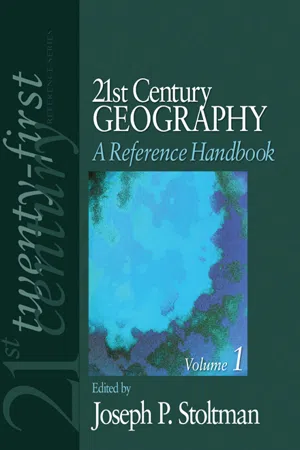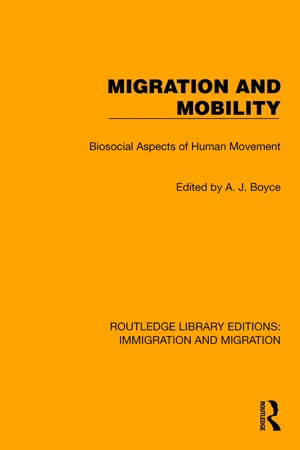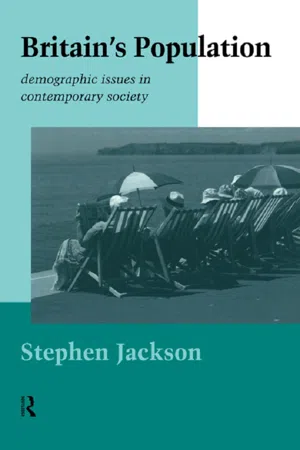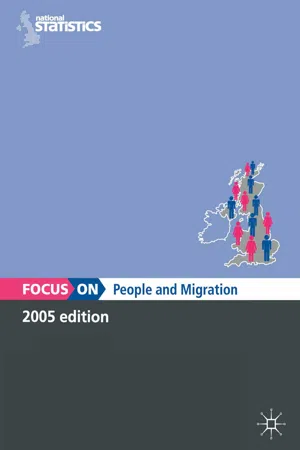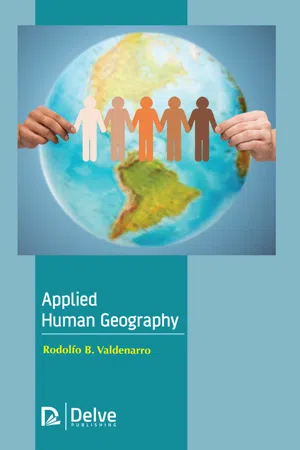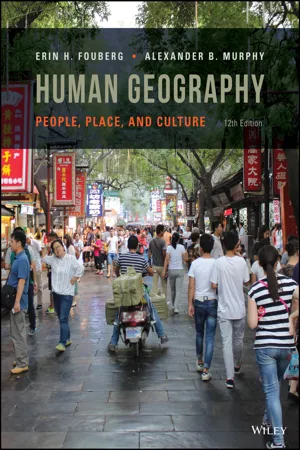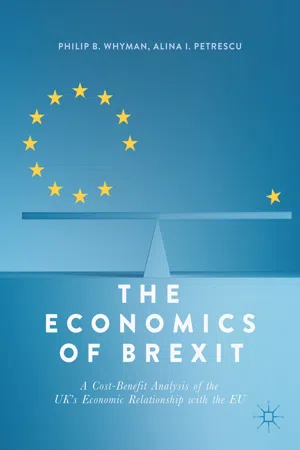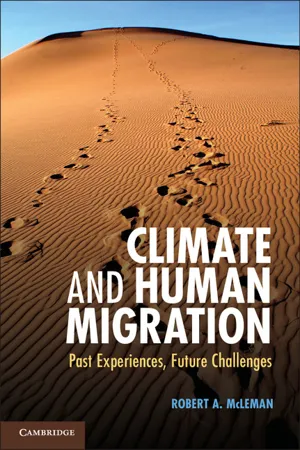Geography
UK Migration
UK migration refers to the movement of people into and out of the United Kingdom. It encompasses both international migration, involving individuals from other countries, and internal migration, which involves movement within the UK. Factors influencing UK migration include economic opportunities, political stability, and social factors, and it has significant impacts on population distribution, cultural diversity, and the economy.
Written by Perlego with AI-assistance
Related key terms
1 of 5
11 Key excerpts on "UK Migration"
- eBook - PDF
- Joseph P. Stoltman(Author)
- 2011(Publication Date)
- SAGE Publications, Inc(Publisher)
Migration involves people leaving a place (origin) and arriving at a new place (destination) under varying circum- stances. Migration is not pursued in isolation because the decision to migrate is linked to numerous push and pull factors. If City A has 30% unemployment and City B has a 5% or lower unemployment rate, it seems apparent that the economic hardship would act as the push factor to encourage people to leave City A and the opportunity (low unemployment rate) would act as the factor pulling people toward City B. There are intervening obstacles, which may impede migration, and that discussion is presented later in the chapter. Wherever there are movements of people, there are consequent demographic, social, and economic changes with spatial implications. Geographers study the spatial nature of movement and seek to derive the motives that people have for moving. The geographic contexts for 231 232 • HUMAN GEOGRAPHY migration occurs in multiple forms, such as people fleeing regions experiencing military conflicts, land-poor people settling new lands that are available for agriculture, or the mass migrations of Europeans moving to the Americas during times of religious, economic, and political repres- sion. These movements represent humans' quest for new beginnings and illustrate the migration phenomenon and restructuring of populated places in the world. Geography as a spatial discipline synthesizes and analyzes migration at different scales in the context of a place of origin and a place of destination. What Is Migration? What is migration? It can be defined spatially, based on where and how long individuals change their residential address domestically or internationally. Is the move perma- nent or semipermanent? Is it migration if a person moves from downtown Los Angeles to Hollywood? How about Mr. - eBook - ePub
Migration and Mobility
Biosocial Aspects of Human Movement
- A.J. Boyce(Author)
- 2022(Publication Date)
- Routledge(Publisher)
INTER-URBAN MIGRATION IN BRITAIN: A GEOGRAPHICAL PERSPECTIVE
J.H. JOHNSONDepartment of Geography, University of Lancaster, Bailrigg, Lancaster LA 1 4YW, UKINTRODUCTION
As societies, economies and transport systems become modernized, then more frequent, longer, and more complex movements of population commonly take place. As this spatial mobility of population grows, the resulting diverse movements of population become more and more difficult to fit into an easy typology; but a critical distinction must be made between temporary movements connected with everyday activities and those moves which involve a change of home, with the social and economic costs that this entails (figure 1 ). Not that the two types are independent, since temporary movements provide the opportunity to acquire the information which may lead to permanent migration. For example, retirement moves are often made to resort areas known earlier in life and intra-urban residential moves are frequently made to sectors of the city which are known for other reasons. Focusing on permanent moves (in so far as the term ‘permanent’ can be applied to any population movement in modern urban society), a critical distinction is between those moves which simply involve a change of residence and those which also involve a change in employment (Johnson 1976 ). The study of ‘ labour migration’ – the simultaneous change of job and of home – has taken on greater importance in recent decades for a number of inter-related reasons.FIGURE 1. Some types of population migration.Reduced levels of fertility are leading to parallel falls in natural increase in many parts of the developed world. In Britain, it is likely that the period of relatively rapid population increase since the end of World War II is at last at an end. As a result, population migration of all types is becoming more important in causing changes in population totals and in modifying local population structures. The importance of migration is not merely demographic. In the past many regionally based planning proposals have often assumed that natural increase would more than offset loss by migration. This assumption has usually proved to be true, at least as far as the population totals of major regions are concerned, although not necessarily at a local scale. It could be quite confidently expected that planning errors in the over-provision of houses or jobs could be corrected in the longer term, as total regional population grew. Now, however, mistakes in the allocation of regional investment appear more difficult to adjust (Johnson & Salt 1981 - eBook - ePub
Britain's Population
Demographic Issues in Contemporary Society
- Steven Jackson(Author)
- 2013(Publication Date)
- Routledge(Publisher)
6MIGRATION AND THE GEOGRAPHY OF POPULATION
The patterns of population change in any given area are determined by the combined effects of prevailing trends in fertility, mortality and migration. As noted, Britain’s population in the 1990s is relatively stable, with little inherent potential for natural growth in the foreseeable future and a probable long-term decline. However, a stable national regime masks the importance of more volatile patterns of change within individual localities. Patterns of fertility and mortality vary from place to place in relation to population structure and local economic performance, but the principal influence on local patterns of change is the movement of population. Some areas of Britain have lost significant numbers over the past twenty years, particularly the inner areas of the major metropolitan centres. Other localities have grown substantially as a result of a sustained influx of migrants. The movement of population not only influences the distribution of total numbers but also impacts on local variations in fertility and mortality. Migration flows tend to be selective in terms of age and social status. The influx to. the expanding centres in the South East tends to be characterized by young, skilled or professional adults with the effect of creating a bulge in the age/sex structure and a rise in underlying trends in fertility. The stream of retirement migrants to the English coastal resorts has the reverse effect, adding to the levels of mortality in the receiving communities.Patterns of population movement occur at different levels and at different scales. In Britain the dominant flows are the general drift of population from the industrial districts of the North and West towards the metropolitan economy in the South and East, and the outflow from the larger towns and metropolitan centres towards suburban and rural districts. This latter stream of movement is commonly referred to as ‘counterurbanization’ and reflects a sustained pattern of population redistribution that has been effective at varying rates throughout the twentieth century. At a more local level there is a constant ebb and flow of movement over short distances as a consequence of residential relocation. In this chapter the complex patterns of population movement, reflecting both dimensions of time and space, will be considered at a number of different scales: international migration, inter-regional movements, intra-regional shifts and local mobility. - eBook - PDF
- NA NA(Author)
- 2016(Publication Date)
- Palgrave Macmillan(Publisher)
These include much of Northern Ireland (especially the more rural west), northern Scotland (especially the Shetlands and Eilean Siar), the Glasgow area and south-west Scotland, several of the larger English cities (including Liverpool and Birmingham) and many of the older industrial towns. Rather less expected is the way in which London's overwhelming picture of net migration loss (all except the City of London, Kingston upon Thames, and Lambeth) extends out deep into the Home Counties and indeed south into East Sussex and west into Wiltshire. This must be due largely to the tightness of the housing market in this broad zone, especially around that time as the 'house price ripple' of the late 1990s economic boom moved further out from London. The high net-loss outliers in rural West Oxfordshire and North Yorkshire are likely due to movements of military personnel. Table6.14 Chapter 6: Population movement within the UK Geographical patterns of migration for selected types of people As shown earlier, migration can be a very selective process, involving some types of people much more than others. Differences in the characteristics of those moving in and those moving out can have a significant impact on the population composition of individual places. Chapter 2 describes many of the geographical variations in population characteristics that arise from internal migration and other factors. This chapter describes in further detail the geographical patterns of internal migration relating to four selected characteristics. Age One of the most important features of migration patterns by age is the difference by settlement size. Migration data from the 2001 Census support the assertion that young adults seek out the 'bright city lights' and show that families with children and older people are more likely to move out of large cities than to move to them. - eBook - PDF
- Rodolfo B. Valdenarro(Author)
- 2019(Publication Date)
- Delve Publishing(Publisher)
Migration: The Human Movement to Other Places 9 CONTENTS 9.1. Introduction .................................................................................... 184 9.2. Types Of Migration ......................................................................... 187 9.3. Components Influencing People To Migrate .................................... 190 9.4. Giddens’ Theory Of Structuration And Applications to Migration .... 192 9.5. International Migration Systems ..................................................... 193 9.6. Migration And Urbanization ........................................................... 197 9.7. Scenes of Development And Hazard ............................................... 199 Applied Human Geography 184 This chapter is concerned with migration of human population and its impact on geography. Man has engaged in migration for better opportunities since time immemorial. This chapter classifies migration into different types. It then describes the factors that influence people to migrate. The chapter then describes Giddens’ Theory of Structuration and the way it can be applied to migration. The chapter then talks about various aspects of international migration. The chapter then covers in detail how urbanization and migration are connected. Finally, it describes how migration can lead to development as well as certain hazards. 9.1. INTRODUCTION The development of gatherings and people starting with one spot then onto the next, including a difference in normal habitation. Relocation is normally recognized from versatility all in all by shows of spatial and transient scale. For instance, by show universal movement requires crossing a national limit for a real or planned time of in any event one year. Private versatility, paradoxically, may comprise of a short-separate move between properties in a similar city. Typologies of relocation separate among inner and universal movement, and the two structures are generally contemplated independently. - A. Bloch(Author)
- 2002(Publication Date)
- Palgrave Macmillan(Publisher)
4 Theories of Refugee Migration and Migration to Britain Migration refers to the movement of people and in the context of this work, the concern is international migration, which is the movement of people across international borders. International migration is complex and can involve a number of interacting variables both at the individual level and the structural level. In Europe structural barriers, manifested through increased immigration controls, have gathered pace over the past few decades. These barriers affect access to countries of asylum and the actual migration process itself. Restrictions mean that it is more difficult to enter Europe legally as an asylum seeker. The consequence of border controls and visa restrictions has been the growth in the use of illegal migration routes facilitated by smugglers and traffickers. This necessarily limits the choices available to any potential migrant. This chapter reviews the development of migration theory and its current application for refugees and asylum seekers. The circumstances surrounding any migratory movement are unique and complex, which makes it difficult for any theory to generalize or predict refugee movements. Migration theories derive from a number of academic disciplines including sociology, geography, politics, law and economics. Three of the main approaches used in debates about migration are the neo- classical economic equilibrium perspective, the historical-structuralist approach and migration systems theory (Castles and Miller, 1998). This chapter will first provide an overview of the main theoretical approaches to migration. Second it explores the ways in which the migration experiences of voluntary and forced migrants may differ. Finally, it presents evidence from the case study of refugees and asylum 64 seekers in Newham as a mechanism for exploring the salience of the theoretical paradigms of migration among refugees in Britain.- eBook - ePub
- John Goddard, Anthony Champion(Authors)
- 2018(Publication Date)
- Taylor & Francis(Publisher)
9 Migration within and between labour markets S. R. Kennett Introduction Population redistribution is the most fundamental aspect of change in the urban system. At sub-regional scales, as noted in the previous chapter, migration is the more important and variable determinant of population change. Of the British population in 1971, more than 6 million (or one in eight) were recorded as moving at least once during the previous year. About 17.5 million moved in the five-year period 1966–71, equivalent to more than one-third of the total population or about the size of all the conurbations together. Nevertheless, for various reasons outlined in the first section, the importance of migration has tended to be underestimated. This chapter then outlines some of the features of population movement in the urban system, concentrating on the characteristics of differential migration. This leads to a discussion of the implications of population decentralization for local government fiscal issues, a topic which illustrates the pervasive importance of migration trends. The study of migration in the urban system The migration mechanism itself should be seen as a process rather than a set of independent, unrelated actions. Ideally, it should be viewed through a hierarchically ordered, interacting urban system, instead of a number of discrete towns, cities and rural areas. The temporal dimension is also vital. The influence of previous population distributions and movements should not be overlooked in an analysis of recent trends. The essential characteristics of the present regional population distribution were shaped in the period between the mid-eighteenth century and the First World War. Changes since then have predominantly affected intraregional population patterns - eBook - PDF
Human Geography
People, Place, and Culture
- Erin H. Fouberg, Alexander B. Murphy(Authors)
- 2020(Publication Date)
- Wiley(Publisher)
Most are migrants who reported average salaries of less than $150 a month. This chapter explores why people migrate, whether by force or voluntarily. We discuss where people migrate, both within countries and across country borders, and how governments impact migration. CHAPTER OUTLINE 3.1 Explain migration as a type of movement. • Cyclic Movement • Migration 3.2 Explain Historic and Modern Forced Migration. • Historic Forced Migration • Modern Slavery and Human Trafficking 3.3 Explain the Theories of Migration and Understand the Motivations for Migration. • Laws of Migration and the Gravity Model • Push and Pull Factors 3.4 Identify why refugees are a distinct group of migrants and describe where most refugees migrate. • Distribution of Refugees • Areas of Dislocation 3.5 Determine how government policies impact migration. • Waves of Immigration in the United States • Legal Restrictions Photo by A.B. Murphy. © 2020 John Wiley & Sons, Inc. FIGURE 3.1 Mumbai, India. A view from the top of a high-rise in the central city, looking at one of the slums found tucked between buildings throughout the city. The Census of India reports that more than 50 percent of the Mumbai’s residents live in slums. 3.1 Explain Migration as a Type of Movement 63 Migration is a type of movement that changes both the places migrants leave and the places they go. The movement of peo- ple along paths of migration creates connections and networks among places. Migration changes how people see themselves and others. It also increases spatial interaction and speeds the diffusion of ideas and innovations among places connected through migration. Geographers identify two basic types of movement. Leav- ing home for a defined amount of time and returning home is called cyclic movement. Migration changes the location of home and has a degree of permanence not found in cyclic movement. Migration is movement from a home location to a new place with an intent to stay in the new place permanently. - eBook - PDF
The Economics of Brexit
A Cost-Benefit Analysis of the UK's Economic Relationship with the EU
- Philip B. Whyman, Alina I. Petrescu(Authors)
- 2017(Publication Date)
- Palgrave Macmillan(Publisher)
The economic impact is not the only fac- tor of relevance, since migration can have cultural and social effects too, such as potentially enriching a nation which is embracing diversity, while sometimes also creating unwelcome tensions and fragmentation. However, the economic argument is central. Does increasing migra- tion place an unbearable strain upon public services, housing and infra- structure? Does immigrant labour displace existing residents in the UK labour market? Or does migration increase growth rates and pay more in taxes than drawn in benefits? Does migrant labour possess higher than average skill levels, in comparison with the existing labour force? This chapter will seek to evaluate the evidence pertaining the economic impact of migration. The UK Labour Market—Brief Comparative Statistics Definition Economic migrants are people moving voluntarily from one coun- try (country of origin) to a different country (country of destination) in search of better economic outcomes, such as wages, living stand- ards and/or personal wellbeing. In this chapter, most of the discussion related to ‘migration’ is assumed to centre on economic migrants, to be distinguished from refugees (migrants moving involuntarily to a differ- ent country, trying to escape from adverse events such as famine, floods, earthquakes, or political unrest). Worldwide, the stock of migrants is composed predominantly of economic migrants, at 95% (IMF 2016). There is a problem, however, when seeking to measure migra- tion. For example, should migration figures amalgamate economic migrants and overseas university students, when the latter are only in the UK for a limited time and their ability to work during their stud- ies is limited? Similarly, even the term ‘resident’ can prove difficult to 6 Migration 187 define, thus making migration data less useful than otherwise desired (Migration Advisory Committee 2012: 46). - eBook - PDF
Climate and Human Migration
Past Experiences, Future Challenges
- Robert A. McLeman(Author)
- 2013(Publication Date)
- Cambridge University Press(Publisher)
In a study of migration patterns in the United States, Plane, Henrie, and Perry (2005) found that the attractiveness of larger centers as migration destinations varies considerably by age group. 20 Why People Migrate Ravenstein was also accurate in recognizing that migration cannot be seen simply as discrete, unidirectional flows from point A to point B, but that migration patterns are embedded within other social, economic, and cultural networks and exchanges. Not only does the potential exist for a counter-flow of migration from destination to source region (including return migration), new in-flows of people to the migrant source region from other places may also take place, thereby generating new migra- tion networks (see Massey et al. 1993, Faist 1998, Greiner 2011). In discussing the formation of such networks, Ravenstein introduced the concept of push and pull, which implies that migration is shaped by the combined effects of forces operating at a migrant’s place of origin and at potential destinations. Push forces predispose or incent an individual or household to consider migration, while pull forces shape the comparative attractiveness of alternative settlement locations. Push-pull terminology continues to appear regularly in present-day discussions of migration. Its simplicity makes it a useful shorthand for acknowledging that migration decisions are influ- enced by a combination of factors, but it is essential to recognize that the push-pull concept greatly simplifies a complex process. 2.3 Spatial and Temporal Dimensions of Present-Day Migration In Ravenstein’s studies, a migrant was someone who no longer lived in the place where he or she was born, and this continues to be at the heart of how migration is defined. In an oft-cited article on theories of migration, Everett Lee defined migration as ‘a permanent or semi-permanent change of residence’ (1966: 49). - eBook - PDF
- Ronald Skeldon(Author)
- 2021(Publication Date)
- Edward Elgar Publishing(Publisher)
34 3 Migration conceptualized: the socio-economic context Why people decide to move is a simple question that elicits complex and multi-layered answers. Whether we are trying to explain aggregate migration flows or why individuals choose to participate in those flows will require different approaches and different data. Certainly, individ- uals create the flows, but the reasons why migrants move differ and they illustrate the differences between the macro- and micro-level approaches discussed in Chapter 1. As will be seen, an element of the micro- will always be present in the macro-, and vice versa, but the form of expla- nation varies depending upon whether we are trying to account for the aggregate or the individual. An explanation for migration is of a different order from an explanation why individual migrants choose to move, even if the approaches of the one can inform the findings of the other. This chapter commences with the more macro-level approaches and moves towards the more micro- but proceeds in a more or less chronological order to show the shifts in thinking about migration and linkages among the several ideas. Antecedents Towards the end of the nineteenth century, the German-English geogra- pher and statistician Ernst Georg Ravenstein published two articles that can be seen as providing the foundation upon which modern migration studies were subsequently built. 1 Based upon an examination of inter- nal migration in Britain, Ravenstein formulated a number of “laws of migration” that today we would term “generalizations”. While the actual MIGRATION CONCEPTUALIZED: THE SOCIO-ECONOMIC CONTEXT 35 number of these generalizations was never entirely clear, the best guide remains Grigg who identified 11 (see Box 3.1). 2 BOX 3.1 RAVENSTEIN’S LAWS OF MIGRATION 1. The majority of migrants go only a short distance. 2. Migration proceeds step by step. 3. Migrants going long distances generally go by preference to one of the great centres of commerce or industry.
Index pages curate the most relevant extracts from our library of academic textbooks. They’ve been created using an in-house natural language model (NLM), each adding context and meaning to key research topics.
